6.1E: Exercises
( \newcommand{\kernel}{\mathrm{null}\,}\)
6.1: Graphs of the Sine and Cosine Functions
In the chapter on Trigonometric Functions, we examined trigonometric functions such as the sine function. In this section, we will interpret and create graphs of sine and cosine functions
Verbal
1) Why are the sine and cosine functions called periodic functions?
- Answer
-
The sine and cosine functions have the property that f(x+P)=f(x) for a certain P. This means that the function values repeat for every P units on the x-axis.
2) How does the graph of y=sinx compare with the graph of y=cosx? Explain how you could horizontally translate the graph of y=sinx to obtain y=cosx.
3) For the equation Acos(Bx+C)+Dwhat constants affect the range of the function and how do they affect the range?
- Answer
-
The absolute value of the constant A (amplitude) increases the total range and the constant D (vertical shift) shifts the graph vertically.
4) How does the range of a translated sine function relate to the equation y=Asin(Bx+C)+D
5) How can the unit circle be used to construct the graph of f(t)=sint?
- Answer
-
At the point where the terminal side of t intersects the unit circle, you can determine that the sint equals the y-coordinate of the point.
Graphical
For the following exercises, graph two full periods of each function and state the amplitude, period, and midline. State the maximum and minimum y-values and their corresponding x-values on one period for x>0. Round answers to two decimal places if necessary.
6) f(x)=2sinx
7) f(x)=23cosx
- Answer
-
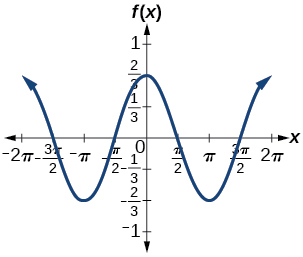
amplitude: 23period: 2πmidline: y=0maximum: y=23 occurs at x=0minimum: y=−23 occurs at x=πfor one period, the graph starts at 0 and ends at 2π.
8) f(x)=−3sinx
Exercise 6.1E.9
f(x)=4sinx
- Answer
-
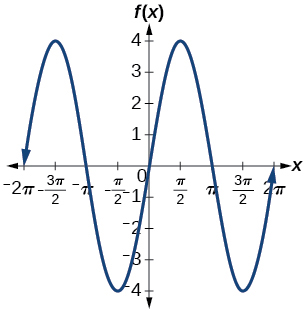
amplitude: 4; period: 2πmidline: y=0maximum y=4 occurs at x=π2minimum: y=−4 occurs at x=3π2one full period occurs from x=0 to x=2π
10) f(x)=2cosx
Exercise 6.1E.11
f(x)=cos(2x)
- Answer
-
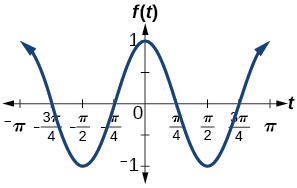
amplitude: 1; period: πmidline:
12) f(x)=2sin(12x)
13) f(x)=4cos(πx)
- Answer
-
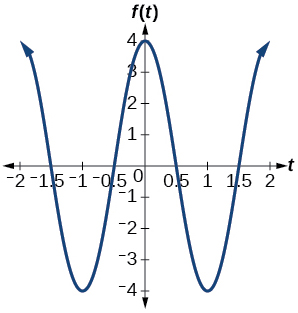
amplitude: 4; period: 2; midline: y=0maximum: y=4 occurs at x=0minimum: y=−4 occurs at x=1
14) f(x)=3cos(65x)
15) y=3sin(8(x+4))+5
- Answer
-
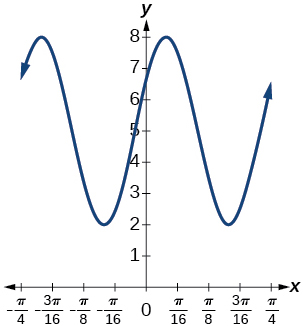
amplitude: 3; period: π2 midline: y=5 maximum: y=8 occurs at x=0.12 minimum: y=2 occurs at x=0.516 horizontal shift: −4 vertical translation 5; one period occurs from x=0 to x=π4
16) y=2sin(3x−21)+4
17) y=5sin(5x+20)−2
- Answer
-
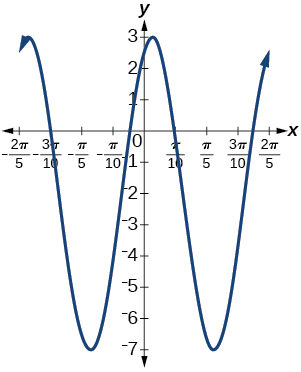
amplitude: 5; period:2π5 midline: y=−2 maximum: y=3 occurs at x=0.08 minimum: y=−7 occurs at x=0.71 phase shift: −4 vertical translation: −2 one full period can be graphed on x=0 tox=2π5
For the following exercises, graph one full period of each function, starting at x=0. For each function, state the amplitude, period, and midline. State the maximum and minimum y-values and their corresponding x-values on one period for x>0. State the phase shift and vertical translation, if applicable. Round answers to two decimal places if necessary.
18) f(t)=2sin(t−5π6)
19) f(t)=−cos(t+π3)+1
- Answer
-
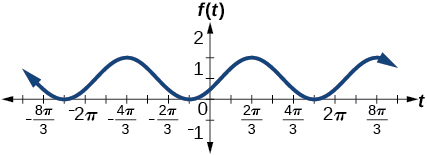
amplitude: 1; period: 2π midline: y=1 maximum: y=2 occurs at x=2.09 maximum: y=2 occurs at t=2.09 minimum: y=0 occurs at t=5.24 phase shift: −π3 vertical translation: 1; one full period is from t=0 to t=2π
20) f(t)=4cos(2(t+π4))−3
21) f(t)=−sin(12t+5π3)
- Answer
-
 amplitude: 1; period: 4π midline: y=0 maximum: y=1 occurs at t=11.52 minimum: y=−1 occurs at t=5.24 phase shift: −10π3 vertical shift: 0
amplitude: 1; period: 4π midline: y=0 maximum: y=1 occurs at t=11.52 minimum: y=−1 occurs at t=5.24 phase shift: −10π3 vertical shift: 0
22) f(x)=4sin(π2(x−3))+7
Exercise 6.1E.23
Determine the amplitude, midline, period, and an equation involving the sine function for the graph shown in Figure below.
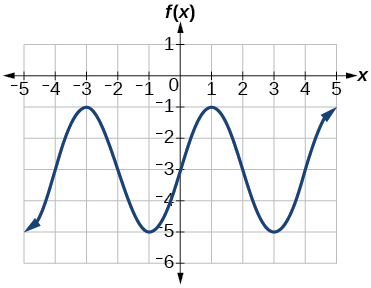
- Answer
-
amplitude: 2; midline: y=−3 ; period: 4; equation: f(x)=2sin(π2x)−3
24) Determine the amplitude, period, midline, and an equation involving cosine for the graph shown in the Figure below.
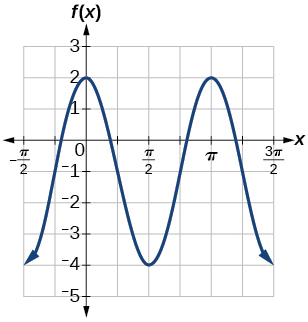
25) Determine the amplitude, period, midline, and an equation involving cosine for the graph shown in the Figure below.
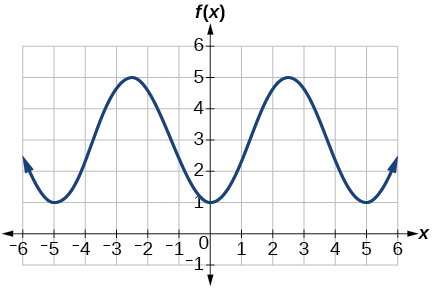
- Answer
-
amplitude: 2; period: 5; midline: y=3 equation: f(x)=−2cos(2π5x)+3
26) Determine the amplitude, period, midline, and an equation involving sine for the graph shown in the Figure below.
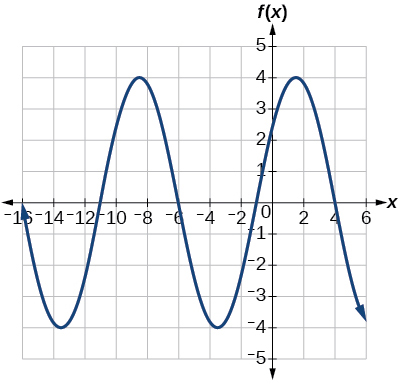
27) Determine the amplitude, period, midline, and an equation involving cosine for the graph shown in the Figure below.
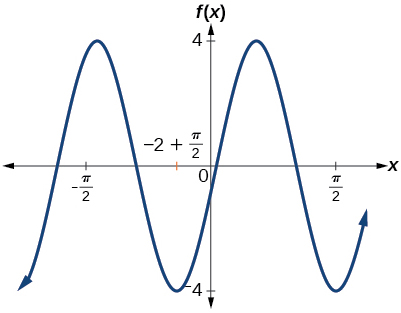
- Answer
-
amplitude: 4; period: 2; midline: y=0 equation: f(x)=−4cos(π(x−π2))
28) Determine the amplitude, period, midline, and an equation involving sine for the graph shown in the Figure below.
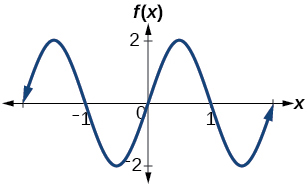
29) Determine the amplitude, period, midline, and an equation involving cosine for the graph shown in the Figure below.
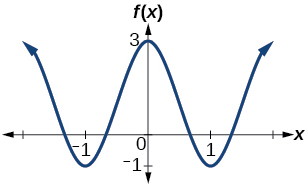
- Answer
-
amplitude: 2; period: 2; midline y=1 equation: f(x)=2cos(πx)+1
30) Determine the amplitude, period, midline, and an equation involving sine for the graph shown in the Figure below.
Algebraic
For the following exercises, let f(x)=sinx
31) On [0,2π) solve f(x)=0
32) On [0,2π) , solve f(x)=12.
- Answer
-
π6, 5π6
33) Evaluate f(π2)
34) On [0,2π), f(x)=√22
- Answer
-
π4, 3π4
35) On [0,2π) the maximum value(s) of the function occur(s) at what x-value(s)?
36) On [0,2π) the minimum value(s) of the function occur(s) at what x-value(s)?
- Answer
-
3π2
37) Show that f(−x)=−f(x) This means that f(x)=sinx is an odd function and possesses symmetry with respect to ________________.
For the following exercises, let f(x)=cosx
38) On [0,2π) solve the equation f(x)=cosx=0
- Answer
-
π2, 3π2
39) On [0,2π) solve f(x)=12.
40) On [0,2π) find the x-intercepts of f(x)=cosx.
- Answer
-
π2, 3π2
41) On [0,2π) find the x-values at which the function has a maximum or minimum value.
42) On [0,2π) solve the equation f(x)=√32
- Answer
-
π6, 11π6
Technology
43) Graph h(x)=x+sinx on [0,2π] Explain why the graph appears as it does.
44) Graph h(x)=x+sinx on [−100,100] Did the graph appear as predicted in the previous exercise?
- Answer
-
The graph appears linear. The linear functions dominate the shape of the graph for large values of x.
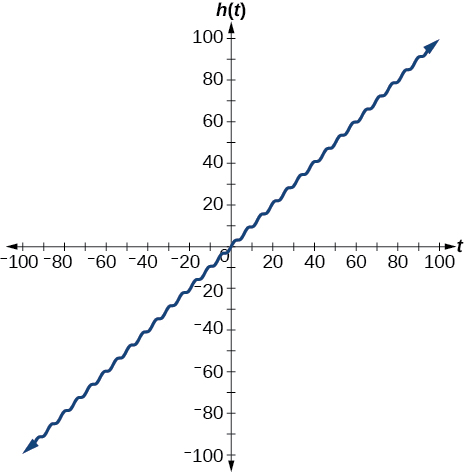
45) Graph f(x)=xsinx on [0,2π] and verbalize how the graph varies from the graph of f(x)=xsinx.
46) Graph f(x)=xsinx on the window [−10,10] and explain what the graph shows.
- Answer
-
The graph is symmetric with respect to the y-axis and there is no amplitude because the function is not periodic.
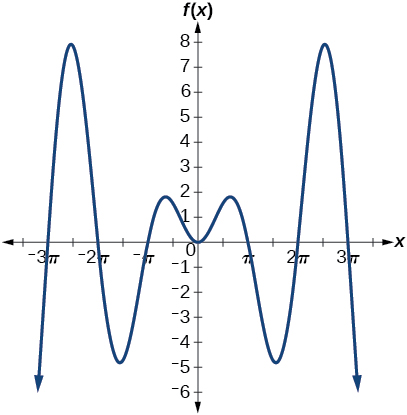
47) Graph f(x)=sinxx on the window [−5π,5π] and explain what the graph shows.
Real-World Applications
48) A Ferris wheel is 25 meters in diameter and boarded from a platform that is 1 meter above the ground. The six o’clock position on the Ferris wheel is level with the loading platform. The wheel completes 1 full revolution in 10 minutes. The function h(t) gives a person’s height in meters above the ground t minutes after the wheel begins to turn.
- Find the amplitude, midline, and period of h(t).
- Find a formula for the height function h(t).
- How high off the ground is a person after 5 minutes?
- Answer
-
- Amplitude: 12.5; period: 10; midline: y=13.5
- h(t)=12.5sin(π5(t−2.5))+13.5
- 26 ft

